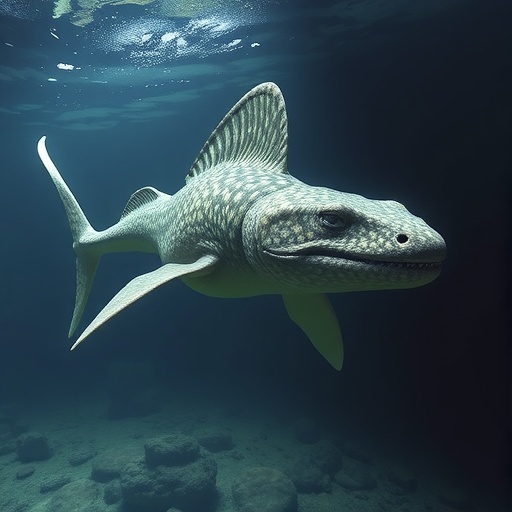In the depths of the Early Jurassic seas, one marine predator reigned supreme not only through sheer size but also through unparalleled adaptations for stealth. The genus Temnodontosaurus, a colossal ichthyosaur that sometimes grew beyond ten meters, occupied apex trophic positions within its ecosystem. Combining formidable physicality with specialized sensory and locomotory traits, these ancient reptiles offer unprecedented insights into evolutionary innovations that shaped marine predation over 180 million years ago.
Central to Temnodontosaurus’ success was its remarkable ocular anatomy. Sporting the largest eyeballs known in the vertebrate fossil record, these huge orbs rivaled those of today’s giant squid species such as Architeuthis. This immense visual apparatus likely served critical roles under dim-light conditions prevalent in deep marine or nocturnal environments. While debate continues over whether their massive eyes evolved primarily for refined visual acuity or for picking up low-resolution signals, consensus points toward powerful adaptations facilitating vision where most other marine predators might falter.
Complementing vision with stealthy movement, Temnodontosaurus exhibited flippers that blurred the line between locomotion and sensory sophistication. Morphometric reconstructions reveal limbs that were not only large but wing-like, optimized for nuanced hydrodynamic function. Analyses utilizing computational fluid dynamics have demonstrated that these flippers possessed specialized trailing edge serrations and surface texturing that suppressed self-induced noise predominantly in low-frequency ranges. This suppression was likely crucial for avoiding detection by prey equipped to perceive subtle water disturbances.
.adsslot_PdcHtTxkWn{ width:728px !important; height:90px !important; }
@media (max-width:1199px) { .adsslot_PdcHtTxkWn{ width:468px !important; height:60px !important; } }
@media (max-width:767px) { .adsslot_PdcHtTxkWn{ width:320px !important; height:50px !important; } }
ADVERTISEMENT
The combination of minimized acoustic footprint and precision maneuverability positioned Temnodontosaurus as a formidable hunter against both vertebrate and soft-bodied cephalopod prey. Fossil evidence of coleoid remains alongside ichthyosaur specimens suggests these stealth adaptations enabled close approaches without triggering escape behaviors in agile and acoustically sensitive invertebrates. This dynamic probably facilitated a predator-prey evolutionary arms race centered on sensory detection and counter-detection strategies.
Furthermore, the fleshy tips of the flippers featured passive flow control cues that helped negate pressure fluctuations—a key factor in reducing mechanosensory detection by prey or rival predators. Such adaptations minimized turbulent wakes and hydrodynamic noise. This morphological fine-tuning, rare among vertebrates, speaks to a deep evolutionary pressure favoring cryptic hunting strategies alongside immense physical stature.
Intriguingly, the sensory systems of Temnodontosaurus may have extended beyond vision and hydrodynamic stealth. Fossilized ultrastructural ‘pores’ bear strong resemblance to scale organs in extant reptiles known for mechanoreception. This suggests the possibility that these ancient marine reptiles possessed cutaneous receptors capable of sensing water-borne stimuli, thus enhancing spatial awareness in murky or low-light aquatic environments. While direct evidence of sophisticated directional hearing is lacking, low-frequency sound detection was probably well within their sensory repertoire.
Modern parallels highlight the importance of auditory cues in marine animals’ survival, from fish to marine mammals. This ancient predator-prey dynamic offers a window into evolutionary pressures that shaped sensory modalities still relevant today. The increasing anthropogenic noise pollution in modern oceans raises concerns about interference with these natural sensory processes, a problem that underscores the timeless importance of sound and stealth in aquatic life.
Contemporary engineering endeavors have begun to mimic biological flow control devices similar to those observed in Temnodontosaurus flippers. Trailing edge serrations and textured surfaces are under active research for noise reduction on ship propellers and renewable energy devices, demonstrating an inspiring convergence between paleobiology and biomimetic design. The fact that such biological solutions existed almost 200 million years ago underscores nature’s ingenuity in solving complex physical challenges.
By integrating fossil data, morphometrics, and fluid dynamic simulations, researchers have dramatically expanded our understanding of how Temnodontosaurus combined extreme size with functional stealth. This ancient ichthyosaur stands not only as a testament to Jurassic marine ecosystem complexity but also as an evolutionary marvel of sensory and locomotor adaptation. Its legacy continues to inform modern biology, biomimetics, and the preservation of marine environmental integrity.
The revelations surrounding Temnodontosaurus also encourage a re-examination of predator-prey dynamics in paleoecological contexts, emphasizing sensory ecology as a vital axis driving evolutionary trajectories. Such investigations deepen our appreciation for the delicate balance these marine reptiles maintained between power and subtlety—an equilibrium essential to their dominance in Jurassic seas.
In conclusion, the wing-like flippers of Temnodontosaurus represent more than just anatomical curiosities. They embody a sophisticated suite of adaptations finely tuned to stealthy predation, integrating complex sensory functions with hydrodynamic innovations. This duality of extreme visual capability and silent locomotion reveals an evolutionary strategy of early marine vertebrates that resonates profoundly with both ancient ecosystems and contemporary scientific frontiers.
Subject of Research: Adaptations for stealth and sensory capabilities in the Jurassic ichthyosaur Temnodontosaurus
Article Title: Adaptations for stealth in the wing-like flippers of a large ichthyosaur
Article References:
Lindgren, J., Lomax, D.R., Szász, RZ. et al. Adaptations for stealth in the wing-like flippers of a large ichthyosaur. Nature (2025). https://doi.org/10.1038/s41586-025-09271-w
Image Credits: AI Generated
Tags: adaptations for low-light environmentsapex trophic positions in the oceanEarly Jurassic marine ecosystemshydrodynamic function of flipperslarge ichthyosaur flipperslocomotion in prehistoric marine animalsmarine predator evolutionmorphological innovations in ichthyosaurssensory adaptations in ancient reptilesstealth adaptations in ichthyosaursTemnodontosaurus ocular anatomyvisual acuity in marine predators





